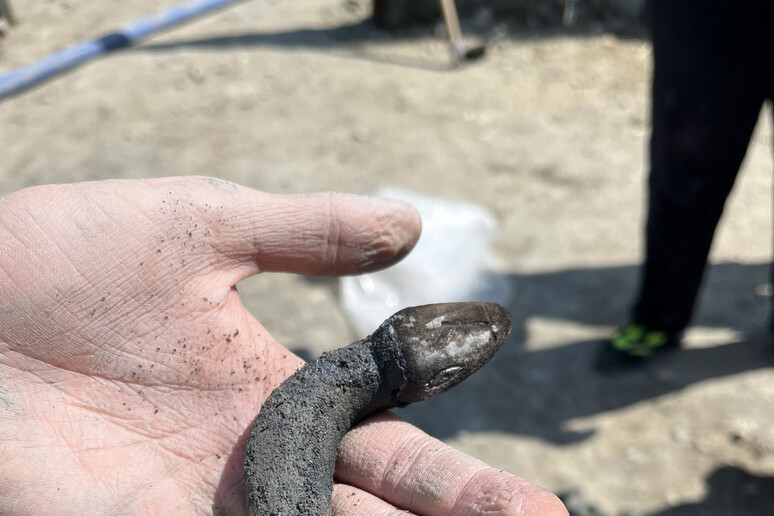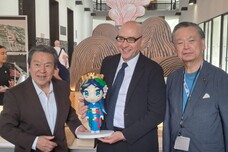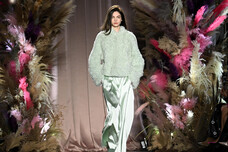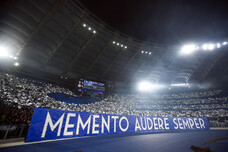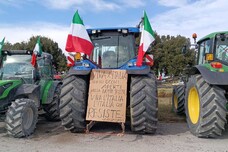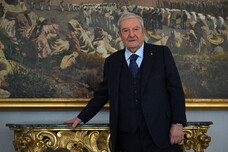(by correspondent
Silvia Lambertucci)
Two glittering crowns, jewels, cases of shiny coins. Along with
new, extraordinary bronze statues recovered from the mud, gold
is the latest surprise of San Casciano dei Bagni.
A treasure trove of objects and inscriptions that is once again
accompanied by stories and intriguing mysteries: because at the
bottom of the Bagno Grande pool, which was Etruscan and then
Roman, the archaeologists who today, together with the Minister
of Culture Alessandro Giuli and the head of the archaeology
department Luigi La Rocca, are presenting the latest findings to
the press, found themselves faced this year with a sea of
;;snakes forged in bronze among which stands out, majestic and
monumental, a specimen almost a meter long, just like the
splendid statues that have already made the Tuscan site known
throughout the world.
"An infinite surprise," smiles Jacopo Tabolli, the professor at
the University for Foreigners of Siena, who together with
Emanuele Mariotti, director of the excavation and Ada Salvi,
pointwoman for the superintendency, has been leading the
adventure of this excavation since 2019.
Nothing scary: with its sinuous body, shiny scales, horned and
bearded head, the large serpent, Tabolli points out, "almost
seems to smile."
It is a good demon, one of those that the Romans called
agatodaemons, the cute snakes that adorn many larariums in the
houses of Pompeii.
Even its location here makes sense: it was placed at the point
where the water flowed, because with its coils it represented
the sacredness of the source.
A fundamental character, therefore, "the genius loci" of the
system of offerings.
Here then is the other element of novelty: because the serpent
has been associated with divination since ancient times.
And its discovery is the confirmation that people also came to
the source "to have a direct relationship with the divinity", to
question the serpent, or the springs, about the unknowns of the
future.
"It is as if the little snakes and the agatodaemon, with the
waters that flow continuously, brought a message to the divinity
of the springs and to those of health", explain Salvi and
Mariotti.
In short, it was not only health that was on the minds of those
who frequented this very special place, where even today the
gaze is lost between the blue of the sky, the greens and the
ochre of the Tuscan hills.
Among the offerings returned by the mud, the nymphs appeared - a
bronze example and an inscription - as well as many chicken's
eggs, in some cases incredibly intact.
And then coins, over 10 thousand, piled up as if they had been
immersed in large containers that have dissolved over the
centuries.
The gold crowns, one whole in the shape of a tapeworm, the other
in fragments, were among the novelties, as was a ring with amber
and other jewels.
But once again it is the statues and the bronze heads that
strike the heart, with the refinement of their workmanship and
the cargo of life that accompanies them, the inscriptions in
Etruscan or Latin like messages in bottles from a world
thousands of years away.
Among the many - there are four of the largest - the trunk of a
male body cut in half offered to the springs by a certain Gaius
Roscius, who lived in the 1st century BC, is surprising.
A type of offering, Tabolli begins, that has a long tradition
behind it: "The healed part was offered", he explains.
What is surprising, rather, is the very high quality of the
artifact, a model that is even inspired by Alexander the Great.
And yet, if the half body of Gaius Roscius amazes, what is
perhaps most touching is the statue, forged in the 2nd century
BC. B.C., of a child portrayed standing with his little dress:
in his hand he holds a ball that the craftsman has reproduced
impeccably, even reproducing the tiny stitching in bronze.
It moves incredibly, today as it did more than 2 thousand years
ago, rotating on the palm.
It is useless to look for the history of this little boy because
he too, like the snake, seems linked to divination:
"Children who had the role of little augurs", explain the
archaeologists, pointing to the bracelet, coincidentally in the
shape of a snake that wraps around his little wrist.
And then the inscription on the leg, which mentions for the
first time the Etruscan city-state of Cleusi, today's Chiusi.
A statue that certainly had an important role, so much so that
the golden crown, they hypothesize, could have belonged to him.
It is difficult to say now, even if, at the same time as the
restorations, specialists from all over the world are already
busy studying every aspect of the new findings.
In the summer, excavation will resume, while work is being done
to create the Thermal Archaeological Park, the Museum and the
International Research Hub that should make it possible for
everyone to enjoy so much wonder from the end of 2026.
But in the meantime, season after season, one discovery after
another, this very special place really seems to re-emerge from
the vapours of its waters, repopulated with faces and human
stories, with joys, sorrows, hopes for the future.
A distant world, which is not so distant after all.
ALL RIGHTS RESERVED © Copyright ANSA
